Military Intelligence in the Battle of the Caucasus
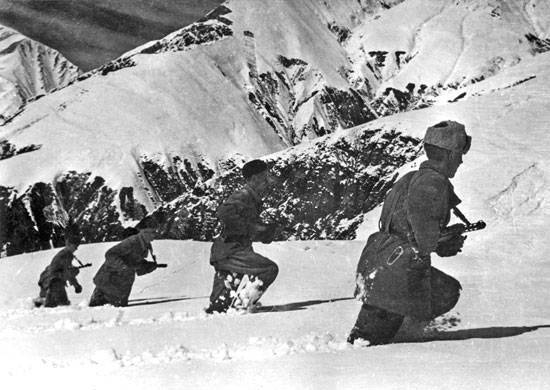
In the summer of 1942, the situation on the Soviet-German front was characterized by a number of complex strategic and tactical circumstances of a military and military-political nature. The allies of the USSR in the anti-Hitler coalition, the United States and Great Britain, were delaying the opening of a second front in Europe. The uncertainty of the situation was intensified by the preparation of the Turkish and Japanese governments to enter the war against the Soviet Union on the side of Germany. After the failure of Operation Typhoon, whose main objective was to seize Moscow, the command of the German armed forces developed new guidelines for the conduct of the war on the eastern front. The essence of these instructions was to demonstrate the threat of a new strike on the Moscow direction, which was supposed to cover the main operations of the German troops on the southern flank of the Soviet-German front. Hitler decided to seize the North Caucasus.
The initial plan of mastering the resources of the North Caucasus was considered by the German command in the summer of 1941 and was specified in a document called “Operation from the North Caucasus region through the Caucasus Mountains and North-Western Iran in order to master the passes of Rawanduz and Hinagan in the Iran-Iraq direction”. Planning the seizure of the North Caucasus, the German command was preparing not only to take advantage of the rich resources of this region, but also to extend Germany’s influence to all of South Caucasus and even to the Middle East with its oil reserves. However, in 1941, Hitler was unable to proceed with the implementation of the idea of seizing the North Caucasus. Blitzkrieg failed, Operation Typhoon, which envisaged the seizure of Moscow, also failed.
For a radical change in the situation on the eastern front, the German command needed new designs that could bring victory in the war against the USSR. Therefore, in the summer of 1942, Hitler ordered the development of a plan to seize the North Caucasus. The Fuhrer believed that with any development of events on the eastern front, the seizure of the North Caucasus would significantly limit the supply of oil and food to the Red Army, as well as interrupt supplies of military materials from the United States and Great Britain via the southern route to the USSR through Iran. The reduction of economic opportunities was supposed, as was evidently believed in Berlin, to deprive the Soviet Union of the prospects for waging war against Germany.
Planning to seize the Caucasus, Hitler wanted to take advantage of the unique opportunity presented to him in the summer of 1942. It consisted in the fact that the United States and Great Britain did not fulfill their obligations to open a second front in Europe, which allowed the German command to concentrate the maximum number of troops on the Soviet-German front and aim them at seizing the Caucasus, after which it was planned to inflict a second blow on the Moscow sector.
Following the instructions of the Führer, Hitler's generals in July 1942 completed the development of a plan to seize the Caucasus and report it to Hitler at the Werewolf headquarters near Vinnitsa. 23 July 1942 The Fuhrer signed directive No. 45. It stated: “During the campaign, which lasted less than three weeks, the big tasks that I set for the southern wing of the Eastern Front were mostly fulfilled. Only small forces of Tymoshenko’s armies managed to escape from encirclement and reach the southern coast of the r. Don. We must reckon with the fact that they will be strengthened by the troops in the Caucasus. ”
The directive set forth the immediate tasks of the German troops. It, in particular, indicated that the immediate task of the ground forces of Army Group A was to encircle and destroy the enemy forces that had left the Don in the area south and southeast of Rostov. To do this, mobile units of the ground forces were ordered to advance in the general direction to the south-west, to Tikhoretsk from bridgeheads, which had to be created in the area of settlements Konstantinovskaya and Tsimlyanskaya. The infantry, chasseurs and mountain rifle divisions were ordered to cross the Don in the Rostov region, the advance units were tasked to cut the railway line Tikhoretsk - Stalingrad ...
After the destruction of the Red Army troops south of the Don, the main task of Army Group A was to capture the entire eastern coast of the Black Sea, capture the Black Sea ports and eliminate the Black Sea fleet.
The second grouping, in which, on the orders of Hitler, mountain rifle regiments and Eger divisions were assembled, was ordered to force the Kuban and seize the hill on which were Maikop and Armavir.
Other mobile units of the German troops were to seize the Grozny area and, with part of the forces, cut the Military Ossetian and Georgian Military roads. Then the German generals planned to capture Baku along the coast of the Caspian Sea. The operation of Army Group "A" to capture the Caucasus received the code name "Edelweiss".
Army Group “B” was assigned the task of organizing defense along the Don River, advancing on Stalingrad, defeating the forces forming there, occupying the city and closing the isthmus between the Volga and the Don. The operations of Army Group "B" received the code name "Fishreher."
The 4 clause of Hitler's 23 directive from July 1942 stated: “When developing plans based on this directive and transferring it to other authorities, as well as issuing orders and instructions related to it, follow the order of July 12 to keep the secret.” These instructions meant that the development of all operational documents and the transfer of troops to seize the Caucasus were to be carried out by all involved headquarters under special secrecy.
So, in the conditions of heightened secrecy, an operation was planned to capture the North Caucasus.
Hitler's directive with the plan of Operation Edelweiss to Field Marshal V. Liszt’s headquarters, which was stationed in Stalino (now Donetsk, Ukraine), received 25 July 1942.
Do not give the Germans a breather ...
In Moscow in the spring of 1942, extraordinary events occurred. There was still no information about Operation Edelweiss at the General Headquarters (Supreme Command). But after the selected German divisions were driven back from Moscow, I.V. Stalin and his assistants believed that German troops could be expelled from the territory of the Soviet Union and victory in 1942 could be achieved.
10 January 1942 Mr. Stalin signed a directive letter addressed to Soviet military leaders. The intentions of the enemy and the tasks of the Red Army in that letter were defined as follows: “... After the Red Army managed to exhaust the German fascist troops enough, it launched a counter-offensive and drove the German invaders to the west.
In order to delay our advance, the Germans went over to the defense and began to build defensive lines with trenches, barriers, field fortifications. Thus, the Germans expect to delay our offensive until the spring, so that in the spring, by gathering strength, they will again go on the offensive against the Red Army. The Germans, therefore, want to gain time and get a breather.
Our task is not to give the Germans this respite, drive them westward without stopping, force them to use up their reserves before spring, when we have new big reserves, and the Germans will not have more reserves, and ensure, in this way , the complete defeat of Hitler's troops in 1942 year. "
“Not to give the Germans a break and drive them to the west without stopping” was desirable, but practically not a real deal. The war demanded accurate calculations, reliable intelligence and well-founded decisions. Moreover, there were no sufficient reserves at the beginning of 1942 at the Supreme Command Headquarters, therefore the Red Army was simply unable to ensure the complete defeat of the Nazi troops in 1942. However, no one dared to object to the Supreme Commander.
In the General Staff of the Red Army in the spring of 1942, military intelligence reports on Hitler's plans to wage war on the eastern front were perceived with particular concern. These reports contradicted Stalin’s directives and said that Nazi Germany did not intend to defend itself, but, on the contrary, was preparing for a new major offensive.
What did the GRU residents report?
Residents of Soviet military intelligence, operating in Ankara, Geneva, London, Stockholm and Tokyo, reported to the Center that Hitler was preparing troops for a new major offensive. Residents of the Red Army General Staff Intelligence Administration reported to the Center about the material and human reserves of fascist Germany, about the efforts of the German Foreign Minister Ribbentrop, who, following Hitler's instructions, sought to draw Japan and Turkey into the war against the USSR. The performance of these states on the side of Germany would undoubtedly strengthen the German coalition and could change the situation on the Soviet-German front in favor of Germany. If the Soviet Union had to fight simultaneously on three fronts (in the Far East - against Japan, in the south - against Turkey and on the Soviet-German front - against Germany and its allies), it is difficult to guess how the Soviet Union would end up 1942.
Residents of the Soviet military intelligence in January-March 1942 reported to the Center that the German command plans to stop the offensive of the Red Army and launch a counteroffensive in order to achieve decisive success on the southern flank of the Soviet-German front.
In January-March 1942, the words “southern flank of the Soviet-German front” and “Caucasus” were frequently encountered in reports from residents of military intelligence. The concept of a new strategic plan for Hitler in the war against the USSR on 1942 was revealed by Soviet intelligence officers gradually. It became clear that Hitler, having lost the opportunity to capture Moscow, decided to demonstrate the threat of a new attack on the Soviet capital, and in fact to seize Stalingrad, cut off the Red Army from the sources of Caucasian oil, deprive it of food reserves coming from the southern regions of the country along the Volga, and interrupt the supply of military aid to the Soviet Union from the USA and England through the territory of Iran.
Information from residents of military intelligence to the Center showed that Hitler planned to use the new front weapon and military equipment, to apply new methods of warfare, and also to send military units to the Eastern front, staffed by German intelligence from Soviet prisoners of war of various nationalities. To understand this stream of numerous intelligence reports was not easy. But in the Intelligence Agency already knew how to extract and efficiently process the information obtained.
A resident of military intelligence, Major A. Sizov, who acted in London, at the beginning of 1942 reported to the Center that he had received reliable information from a trusted source, according to which “... the plan of the German advance to the east foresees two directions:
A strike at Leningrad to reinforce Finland and break the communication with the White Sea (the cessation of deliveries of military goods from Britain and the United States, that is, the disruption of military aid from the allies to the Soviet Union. - V.L.)
The attack on the Caucasus, where the main effort is foreseen in the direction of Stalingrad and secondary to Rostov, and in addition, through the Crimea to Maykop ...
The main goal of the offensive is to capture the Volga throughout its entirety ... ".
Further, Sizov, who was listed in the Center under the pseudonym "Edward", reported that, according to the source, the Germans have "... on the eastern front 80 divisions, of which 25 tank... These divisions did not take part in the winter offensive. "
According to an agent who was associated with authoritative circles in Germany, had confidential communications at the General Staff of the Wehrmacht, the German command planned to launch an offensive on April 10-15.
Another military intelligence source operating in Sofia reported to the 11 1942 Center in February: “... the Bulgarian Foreign Minister reported that the Germans had asked Bulgaria to occupy the southeastern part of Yugoslavia, because the Germans did not have enough forces to have garrisons throughout the country . He believes that the Russian offensive will be exhausted by the spring and that the German counteroffensive in the spring will be successful ... ”
The Soviet military intelligence learned the content of the report of the Bulgarian military attache accredited in Ankara. The Bulgarian military representative in Ankara 2 March, March 1942 reported to Sofia:
Germany will launch its offensive on the eastern front against the USSR between April 15 and May 1.
The offensive will not have the character of lightning, but will be conducted slowly in order to achieve success.
Turks fear that the Soviet fleet will try to escape through the Bosphorus. The following measures will be taken against this:
As soon as the German offensive begins, the Turks will begin to regroup their forces, concentrating them in the Caucasus and the Black Sea.
From the same moment, the orientation of Turkey’s policy towards Germany will begin ... ”
The report of the military intelligence resident, received by the 5 Center in March 1942, at the direction of the head of the Main Intelligence Directorate (GRU) of the General Staff of the Spacecraft was sent to members of the State Defense Committee. First of all, I.V. Stalin, V.M. Molotov, L.P. Beria, A.I. Mikoyan, as well as the Chief of General Staff.
The main message in the military intelligence reports in January-March of 1942 was a substantiated assertion that Hitler determined the direction of the main attack of the 1942 summer campaign, which would be inflicted by the German troops on the southern flank of the front and aimed at conquering the Caucasus.
The Soviet military intelligence at the beginning of 1942 did not yet have information about the existence of the Edelweiss plan of operation, but the evidence that Hitler plans to launch a major blow to the Caucasus in the summer of 1942 was confirmed by reports from many sources. These data were supplemented by information from operational intelligence, which began to record the increased concentration of German troops on the southern flank of the Soviet-German front.
In the General Staff, which at that time was commanded by Army General A.M. Vasilevsky, they understood that the enemy was not broken, he stabilized the front line, and he was trying to use a period of relative calm in combat operations to replenish the troops with personnel and new combat equipment.
Recalling those tense days, Army General S.M. Shtemenko wrote: “... I must say that the Soviet strategic leadership, headed by I.V. Stalin was convinced that sooner or later the enemy would again bring down the blow on Moscow. This conviction of the Supreme Commander was based not only on the danger that threatened Rzhevskiy ledge. There were data from abroad that the Nazi command had not yet abandoned its plan to seize our capital. I.V. Stalin allowed various options for the enemy’s actions, but he believed that in all cases the goal of the Wehrmacht’s operations and the general direction of its attack would be Moscow ... On this basis, it was thought that the fate of the 1942 summer campaign of the year on which the subsequent course of the war depended would be decided near Moscow. Consequently, the central - Moscow - direction will become the main one, while other strategic directions will play a secondary role at this stage of the war.
As it turned out, the Stavka and General Staff forecast was erroneous ... ”.
Apparently, military intelligence reports in January-March of 1942 in the Supreme Command Headquarters and the General Staff did not receive due attention, which led to a serious error in forecasting the actions of German troops on the Soviet front in the summer of 1942. It turned out that military intelligence was reporting information about the enemy which were not taken into account by the Operational Directorate of the General Staff.
Stalin continued to strengthen the defense of Moscow and prepare the troops for active strategic defense. The General Staff, taking into account the recommendations of Stalin, was preparing for active defensive actions.
Hitler secretly prepared to deliver his main attack in the direction of the Caucasus.
The plans of the Soviet General Staff, which envisaged private offensive operations in 1942 near Leningrad, in the Demyansk region, in Smolensk and Lgovsko-Kursk sectors, in the Kharkiv region and in the Crimea, in 1942 did not bring success.
What did General Oshima report in Tokyo?
In the first half of 1942, military intelligence reported to the General Staff that Germany, preparing to strike in the south, was eager to expand its coalition and plans to draw Japan and Turkey into the war against the USSR. However, the Japanese and the Turks were in no hurry to support Hitler’s plans and were expecting a more favorable moment.
The military intelligence officer Richard Sorge reported to the Center about the waiting position taken by the Japanese government in the second half of 1941. After Sorge was arrested by the Japanese counterintelligence, information about the military and political plans of the Japanese government was reported to the Center from London, Major General Ivan Sklyarov, from Washington - captain Lev Sergeyev, from Geneva - Sandor Rado. Information from these residents reflected the desire of the Japanese leadership to establish itself, primarily in the vast expanses of China and Southeast Asia. At the same time, the scouts reported to the Center that if German forces on the eastern front succeeded, the Japanese could enter the war against the USSR on the German side.
Thanks to reliable information obtained in a timely manner by military intelligence, the leadership of the USSR reacted restrainedly to many clearly provocative actions of Japan, which did not allow the Japanese to find a pretext for joining the war on the German side.
Hitler 23 July approved the directive number 45, according to which Army Group "B" was to rapidly capture Stalingrad, Astrakhan and gain a foothold on the Volga. Soon the German troops captured Rostov-on-Don. The gates to the Caucasus were open. The Red Army troops continued to retreat to the Volga.
In the implementation of the plan for the capture of the Caucasus, the Germans were to be helped by the Hungarian, Italian mountain-rifle and Romanian troops. This was reported to Moscow by residents of military intelligence, Colonels A. Yakovlev from Bulgaria and N. Lyakhterov from Turkey, as well as Sandor Rado from Switzerland.
25 July 1942 German troops launched an offensive. Having broken through the defenses of the Bryansk and Southwestern fronts, the 6-I field army developed an offensive and by the middle of July reached the big bend of the Don.
The attack on the Caucasus developed rapidly. For complete confidence in the victory of Hitler, apparently, it was necessary that Japan began military operations against the USSR in the Far East. In pursuit of this goal, Hitler instructed German Foreign Minister I. Ribbentrop in early August to organize the trip of the Japanese ambassador, General Oshima, to the southern flank of the eastern front. The Germans wanted to convince the Japanese that they would achieve victory in 1942, and tried to push Japan into the war against the USSR.
Ribbentrop Hitler's instructions fulfilled. General Oshima visited the southern flank of the Soviet-German front, where he could be convinced that the German troops had already captured Rostov-on-Don and were rushing towards Stalingrad and the Caucasus.
After a trip to the front, Oshima wrote a detailed report on the trip to the front and his impressions. An experienced diplomat and military intelligence officer, Oshima reported in Tokyo that German troops were well trained and well armed, high fighting spirit in the armies on the southern flank, and that officers and soldiers had no doubt that the Soviet Union would soon win. The report, in general, corresponded to the actual state of affairs in the troops of the German army, but Oshima did not know what was happening on the other side of the front.
The Soviet military intelligence learned about the trip of the Japanese ambassador to the southern flank of the eastern front. Oshima’s report, which he sent to Tokyo, was produced. On the basis of this document, a special message was prepared at the GRU, which was sent to all the members of the Supreme Command Headquarters. “... According to trustworthy intelligence data,” reported I.V. To Stalin, the military intelligence chief, the Japanese ambassador in Berlin, General Oshima, reported to Tokyo about his visit at the invitation of the German command of the southern sector of the Eastern Front. The trip was made from 1 to 7 August 1942, by plane on the route: Berlin - the main rate, Odessa, Nikolaev, Simferopol, Rostov-on-Don, Bataysk, Kiev, Krakow, Berlin ... ".
Oshima wanted the Japanese government to take a decision and start military operations against the USSR in the Far East. However, Japan waited. The Japanese leadership had certain commitments to Hitler, but in 1942 sought to solve its problems in Southeast Asia. The Japanese could enter the war against the USSR only if Germany achieved major military success on the eastern front. The battle for the Caucasus has just begun. The main battles were still ahead.
A critical situation was created on the southern flank of the Soviet-German front. Operational and military intelligence of the retreating Soviet troops were not ready for action in such conditions. Military intelligence officers did not think that once they would have to fight on their own territory, so the intelligence officers in Rostov-on-Don, Taganrog, Salsk and other cities did not have their residencies. But information about the enemy was required every day, therefore ordinary fighters were sent over the front line, which did not have a clear boundary, more often boys and girls from Cossack farms and villages. Hope was for their resourcefulness, dexterity and knowledge of their native land. Returning to the intelligence departments (RO) of the headquarters, the young intelligence officers reported on where the enemy was located, which settlement he occupied, and in which direction his tanks were moving. However, the situation changed quickly. Also, many intelligence services were quickly becoming obsolete. Nevertheless, this information was of considerable value, since it helped commanders avoid collisions with superior enemy forces.
The battles were stubborn, the enemy steppes passed the Don steppes and rushed to the Volga.
The news of news agencies from the eastern front followed the whole world. Of particular interest to the events in the Stalingrad area were the governments of Japan and Turkey.
Military intelligence officer Lev Sergeev, who was operating in Washington, was able to obtain reliable information that in 1942, the Japanese government did not plan to launch military operations against the USSR. The report of Sergeyev was of exceptional value, but required confirmation. The data confirming Sergeev’s report came from the GRU residency in Tokyo, which was led by Lieutenant Colonel K. Sonin, as well as from the heads of intelligence departments of the Far Eastern districts headquarters, who constantly monitored the actions of units and divisions of the Japanese Kwantung Army stationed in Manchuria. Apparently, the victory of the Red Army in the Battle of Moscow somewhat cooled the ardor of the Japanese generals and admirals and made them more soberly assess the situation on the Soviet-German front. General Oshima’s calls in Tokyo were taken into account, but the Japanese preferred to act in Southeast Asia. There, victories were given to them faster and easier.
In neutral turkey
The political leadership of Turkey closely watched the course of military operations in the open spaces of the Rostov Region, Stavropol Territory, in the Stalingrad area and in the foothills of the North Caucasus. Turks, too, would not mind to seize the Caucasus territory, rich in oil and other natural resources. However, the position of Ankara depended on many factors: on the situation on the Soviet-German front, on the actions of the Anglo-Americans, and on the vigorous activity of influential German diplomats accredited in Ankara. The agents of the German special services, who by any means sought the deterioration of Soviet-Turkish relations, also showed great activity in 1942 in Turkey. Agents of German intelligence showed in Ankara exceptional ingenuity.
The actions of the German diplomats in Turkey were led by the German ambassador to Ankara, Franz von Papen, an outstanding, skilled diplomat and ambitious politician.
The name Papen is associated with many political events that took place in Turkey during the Second World War and related to the offensive of the German troops in the direction of the Caucasus. First of all, Papen was the main actor, to whom Berlin commissioned Turkey to be drawn into the war against the USSR. Secondly, Papen was in words a supporter of Hitler, but in fact was rather a secret but deft oppositionist. Thirdly, he nearly fell victim to the secret warfare of the special services, one of whom tried to destroy him in February 1942.
The main task of Ambassador F. Papen in Ankara, as Hitler defined it in 1942, was to drag Turkey into the war against the USSR. The task was challenging. In those years, the Turks would like to own most of the Caucasus and host the Black Sea. But the Turkish government nevertheless understood that the smell of Caucasian oil was pleasant both for the Americans and the British, therefore, it is unlikely that they would agree to the expanding influence of Turkey in this region. In addition, the troops of the Soviet Transcaucasian Front, commanded by Army General I.V. The seals were strong enough to reliably cover the Soviet Transcaucasus. Turks already had historical the experience of the war against Russia was in no hurry to unleash military operations against the USSR, although they were preparing for this by secretly concentrating large military forces in Eastern Anatolia.
In a word, in Ankara and Istanbul, where the residency of the American, British, German and Soviet intelligence agencies existed, from the very first days of the Great Patriotic War a secret and uncompromising war began. The first feature of this war was that the intelligence services of the United States, Britain, Germany, the USSR and other states did not recognize unions and coalitions and acted on their tasks and plans, trying to pragmatically carry out what Washington, London, Berlin and Moscow demanded of them. The second peculiarity of the intelligence reconnaissance in Turkey was that the Turkish counterintelligence did not interfere with the German intelligence officers, looked after the Americans and the British and with particular zeal watched all Soviet diplomatic missions, under the cover of which the Turks believed that the Russian military intelligence was operating.
Colonel Nikolai Lyakhterov was appointed resident of the Soviet military intelligence in Turkey in October 1941. Before being appointed to this position, he was a Soviet military attaché in Budapest. Hungary was among the allies of Germany. Therefore, when Germany treacherously attacked the Soviet Union, the Lyakhters, like other employees of the Soviet official missions, were forced to leave Budapest.
In Moscow, Lyakhterov did not stay long. Soon he was in Ankara, where he began to organize the activities of the Soviet military intelligence. The tasks of Lyakhterov were difficult. The center would like to receive from the Soviet intelligence agents from Turkey accurate information about the actions of the German troops in the Balkans, to know about the activities of German intelligence agents in Turkey, the dynamics of German-Turkish relations, the attitude of the neutral Turkish leadership to the war of Germany against the USSR and much more.
The most important among the “many other things” was, first of all, the state of the Turkish armed forces, the combat readiness of the army, navy and air force, as well as information about the deployment of the main ground forces of Turkey. The Turkish fleet was closely watched by the reconnaissance department of the Black Sea Fleet headquarters, commanded by the experienced military intelligence officer Colonel Dmitry Namgaladze, and the Soviet naval attache in Ankara, Captain 1 of rank Konstantin Rodionov. Moscow did not rule out that Turkey, under the pressure of fascist Germany, could enter the war on Hitler’s side against the USSR. Lyakhterov and his assistants should have been in Ankara and Istanbul, where the Soviet consulate was located, to get answers to the questions the Center was concerned about.
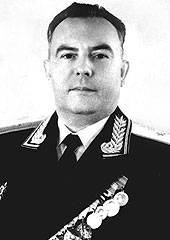 Major General Nikolai Lyakhterov,
Major General Nikolai Lyakhterov, Military Attaché in Turkey (1941-1945)
Army General S.M. Shtemenko wrote about this: “... In the middle of 1942, no one could vouch for the fact that Turkey would not side with Germany. It’s not for nothing that twenty-six Turkish divisions were then concentrated on the border with the Soviet Transcaucasus. The Soviet-Turkish border had to be kept on a strong castle, securing it from any surprises by the forces of the 45 Army. In case the Turkish offensive goes through Iran to Baku, the necessary precautions were taken on the Iranian-Turkish border. ”
Colonel Nikolai Lyakhterov, who had the operational pseudonym "Zif" at the Center, and his assistants made a lot of efforts to solve difficult reconnaissance tasks.
After arriving in Ankara, Lyakhterov was introduced to the Turkish Minister of War, Chief of the General Staff of the Turkish Armed Forces, met with the Chief of Military Intelligence and other high military ranks, with whom he began to establish useful contacts.
In the second half of 1941, the Lyakhterov residency sent materials to the 120 Center, many of which were important for a correct understanding of the real objectives of the foreign policy of the Turkish government.
16 January 1942 Mr. Lyakhterov was invited to the head of the Turkish military intelligence Colonel Helmi Orai. During the meeting, he told Lyakhterov that the War Minister was asking the Soviet General Staff to share their experience in the fight against the Germans. Apparently, in Turkish military circles, it was not excluded that fascist Germany could launch military actions against Turkey, if its government would oppose the expansion of German influence in the Balkan countries. Therefore, the Turkish Minister of War asked the Soviet General Staff to find an opportunity to transfer to the Turkish General Staff Soviet assessments of the tactics of the German army, its methods of action especially in winter, to report the tactical and technical characteristics of German military equipment: tanks, aircraft, artillery systems, organization of the Wehrmacht. The Turks also asked to be handed over to them, if possible, several German trophies.
The request was unexpected. Nevertheless, Lyakhterov reported to the Center about the "application" of the Turkish Minister of War and asked "to work out a solution on this issue."
According to Lyakhterov, the Turks should have transferred the materials they requested from the German army, which could help improve Soviet-Turkish relations.
In Moscow, the request of the Turkish Minister of War was considered, and a positive decision was made on it. Military diplomacy is a complex and difficult art. Lyakhterov was an experienced military diplomat. He was well aware that by fulfilling the request of the Minister of War of Turkey, he created favorable conditions for his subsequent work.
While fulfilling important military and diplomatic duties, Lyakhterov simultaneously supervised the activities of the Soviet military intelligence station in Turkey. 19 January 1942 he reported to Moscow: “... According to the source“ Zameya ”, the Germans in Ankara, through the recruits from the Caucasus, transferred a shipment of explosives to Kars. The goal is to organize acts of sabotage on the way to transport allied military cargo through Iran to the USSR. The task is to establish the location of the German commando center in Iran, its leaders and composition. ”
At the beginning of 1942, the city of Lyakhterov reported to the Center that German military intelligence is conducting active anti-Soviet measures in Ankara and other Turkish cities aimed at undermining the authority of the USSR and worsening Soviet-Turkish relations.
Shortly thereafter, events occurred in Ankara, which are still remembered by both politicians and historians. 24 February 1942 in the 10 hours of the morning on Ataturk Boulevard in Ankara where the German ambassador Papin was strolling with his wife, in the hands of an unknown young man an improvised explosive device went off. From the blast site to the German ambassador, there were only 17 m. Papen received minor injuries. The wife of the German ambassador was not injured.
The Turkish police surrounded the site of the explosion, detained all of the suspicious ones, among which were a member of the USSR Trade Mission Leonid Kornilov and Soviet Vice-Consul in Istanbul Georgy Pavlov. They were interviewed, and a day later they were arrested and charged with preparing an assassination attempt on the German ambassador.
The Turkish government, which in 1942 was still hiding behind its neutrality and was afraid of the German attack, attached particular importance to the assassination attempt on Papen. We did not want to fight the Turks against fascist Germany, which had conquered almost the whole of Europe. The attack from the USSR on Turkey in 1942 was from the realm of fantasy. Therefore, the Turks, arresting Soviet subjects Pavlov and Kornilov, soon put them on trial, not paying attention to protests from the Soviet embassy. The trial took place on April 1. 1942. The accused did not recognize their involvement in the attempt on the German ambassador. However, the court found Pavlov and Kornilov guilty and sentenced everyone to 20 years in prison.
Both the “attempt” and the related trial in Ankara were turned into a noisy anti-Soviet propaganda campaign. The Turks, of course, wanted to show Hitler that they strictly adhere to the declared neutrality and also strictly punish those who prevent them from doing so.
An attempt on Papen is an incident that still attracts attention. This interest can also be explained by the fact that the world has increasingly become confronted with acts of terrorism more sophisticated and more ambitious. Probably, the attempt on Papen is also attracted by the fact that there are many questions left in this case that were not and still are not answered.
The main version of the explosion on Ataturk Boulevard is the assertion that this was a failed operation by NKVD agents who, at the direction of Stalin, wanted to eliminate Papen. According to this version, the Papena destruction operation was developed and prepared by a group led by the experienced NKVD intelligence officer Naum Etington.
The explosion on Ataturk Boulevard, which took place in 1942, caused a lot of noise in the Turkish capital, spoiled Soviet-Turkish relations, greatly complicated the situation in Ankara, Istanbul and other cities, activated the activities of pro-fascist organizations and groups in Turkey. If it was precisely such results that Atington and his leaders wanted to achieve by preparing an "attempt on Papen," then, one might say, they achieved their goal. After the explosion on Ataturk Boulevard, Turkey became closer to fascist Germany and increased its forces in Eastern Anatolia, which were a serious threat to the security of the USSR in the area.
However, it can hardly be assumed that the NKVD intelligence leadership did not understand that the attempt on Papen would lead to a sharp deterioration in Soviet-Turkish relations.
In this regard, questions - whether there was an attempt on Papen, and who was responsible for the organization of this act? - remain open.
I dare to propose another version based on declassified military intelligence documents.
The assassination of Papen in February 1942 could have been a special operation prepared by one of the special services of the country where the removal of the German ambassador in a neutral country was most beneficial. If it was useless for the Americans and the British, the special services of the USSR and Germany could have organized the attempt. For the Soviet leadership, the destruction of Papen, Hitler's opponent, was unthinkable, because such an action would inevitably lead to a deterioration of Soviet-Turkish relations. In Moscow in 1942, they feared any actions that could aggravate the relations of the USSR with both Japan and Turkey. Therefore, Stalin would never have authorized the operation, as a result of which Turkey would become closer to Germany, which could lead to the creation of a new front in the South Caucasus or to the deployment of German troops through Turkey to the southern borders of the USSR.
In this case, it remains to assume that the attempt on Papen was a skillful staging, prepared and deftly executed by German intelligence officers. If during the staging Papen had died, Hitler would not have lost much. But Papen the Berlin conspirators did not appear to be about to destroy. Scare - yes. And most importantly, they undoubtedly wanted to place all responsibility for this act on Soviet intelligence. The German intelligence officers who were preparing this action could not have foreseen that Soviet subjects would be in the zone of its conduct. And when it happened by chance, this fact was used for all 100% to substantiate the version of the involvement of the Soviet intelligence in the attempt on the German ambassador.
This conclusion is confirmed by the report of Shandor Rado from Switzerland. He was much closer to Berlin, where many provocative plans were developed. To achieve his goals, Hitler could donate not only Papen. In Berlin, in circles close to Hitler, Shandor Rado had reliable sources.
So what did Sandor Rado learn about the attempt on Papen? 6 May 1942 Rado reported to the Center: “... The attempt on Papen in Ankara, according to the Swiss Embassy in Berlin, was organized by Himmler with the help of an SS representative in Belgrade, Grosbera, who is the head of police in Serbia. He has contacted the Yugoslav group to organize this act. The bomb was made in Belgrade, and Russian stamps were put on it. ”
In 100, from the site of the attempted assassination of Papen, there was an official car of the German military attache of General Hans Rode, the head of the German military intelligence in Turkey. Probably General Rode was watching what was going to happen on Ataturk Boulevard. When it was all over the death of the terrorist himself, the general offered Papen assistance and delivered the frightened head of the German diplomatic mission to the embassy.
The explosion on Ataturk Boulevard and the anti-Soviet campaign that broke out after this set up the Turkish public and Turkish inhabitants against the USSR. No one paid attention to the fact that the man who was supposed to "destroy" Papen, was blown up by a mine that was in his hands and worked much earlier than it should have happened. A Bulgarian terrorist, as Turkish police admitted, was killed. For the Turks, the culprit died, for the organizers of the assassination, the main witness of the action died. Moor did his job ...
The time for the assassination attempt on Papen was chosen precisely - the German command was preparing for the implementation of the plan of Operation Edelweiss. If Papen had died, Hitler would have rid himself of his political rival. But Papen did not die. Already after the Second World War and the Nuremberg Trials, in which he was convicted as a war criminal, Papen noted in his memoirs that the terrorist attack in February 1942 in Ankara was prepared by the Gestapo or the British. He did not say a word about Soviet intelligence.
It was extremely difficult for Soviet intelligence officers to operate during the war in neutral Turkey. After the propaganda vortexes around the incident on Ataturk Boulevard subsided, an emergency occurred in the residency headed by Colonel N. Lyakhterov — a resident officer Izmail Akhmedov (Nikolaev) asked the Turks for shelter. Attempts by the staff of the Soviet embassy to return the fugitive ended in vain. Turks Akhmedov not issued. And he gave the Turks their former intelligence comrades, who were forced to leave Turkey.
Despite the difficulties, the GRU residency in Turkey continued to operate. In 1942-1943, that is, during the battle for the Caucasus, Lyakhterov constantly received materials from the Center that revealed the composition, grouping, numbering and deployment of units of the Turkish army. The Center received reports on the political situation in Turkey, Turkish-German contacts, and the situation in the Balkans.
In the summer of 1942, when the situation on the Soviet-German front was especially bad for the Red Army, the number of supporters of the war against the Bolsheviks grew among the ruling elite of Ankara. The Turkish government, which was pursuing a policy hostile towards the USSR, concentrated on the border with the Soviet Union 26 of its divisions. The concentration of Turkish troops in the area was promptly reported to the Center by Colonel N. Lyakhterov. Given this, in the most intense period of the battle for the Caucasus with the fascist German forces, the Supreme Command was forced to hold large forces on the Caucasian border with Turkey.
Soviet military intelligence officers operating in Turkey were the closest to those Turkish government agencies behind whose walls the secret plans of the Turkish leadership were being formed in relation to the USSR. These institutions and their secrets were heavily guarded. However, thanks to the skillfully organized activities of military intelligence officers and their sources, many important secrets of Turkish generals became known in Moscow.
Colonel Makar Mitrofanovich Volosyuk (with the pseudonym "Doksan") arrived in 1943 in Ankara. The center sent him to Turkey as a deputy resident of military intelligence. Volosyuk worked successfully. He succeeded in recruiting the encrypter of the embassy of one of the countries of the block of fascist states, who agreed to sell the codes and secret mail of his military attaché. This agent at the Center has been assigned the nickname "Karl". In 1943-1944, a significant amount of classified material was received from "Karl", many of which were of undoubted interest for Soviet military intelligence.
After some time, Volosyuk managed to recruit another agent who had access to important military and military-political information. During the battle for the Caucasus, and especially at the final stage of the Great Patriotic War, valuable materials came from this agent to the Center. Only in 1944 from sources of residency, led by Colonel N.G. Lyakhterov, the Center received 586 information materials and messages. The most valuable materials came from the illegal intelligence groups "Dilen" and "Dogu", as well as from sources "Balyk", "Dammar", "Dishat" and "Dervish". They had their informants in the German embassy, the staff of the German military attache, the Turkish Ministry of War, the Turkish General Staff and the Ministry of Foreign Affairs.
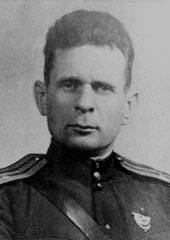 Colonel Makar Mitrofanovich Volosyuk,
Colonel Makar Mitrofanovich Volosyuk,Assistant Air Attaché in Turkey (1943-1946)
Lyakhterov and his associates also reported to the Center that the United States and Britain are pursuing their own policy towards Turkey, which is not consistent with the overall objectives of the war of the allied states against fascist Germany and its satellites. Judging by the data that Lyakhterov sent to the Center, Churchill expected to use Turkey to implement his plans in the Balkans. The Americans and the British supplied Turkey with arms, despite the fact that it could enter the war against the USSR.
Around the "Iranian corridor"
Colonel N. Lyakhterov often sent information to the Center and that German agents were preparing for sabotage actions on the routes of delivery of Allied military cargo through Iran to the USSR. This information caused concern at the Center - an important channel through which the Allied military-technical assistance could be at risk. The residency Lyakhterov and his agents failed to establish the exact location of the German sabotage center and identify its employees, but, nevertheless, a warning from Ankara was sent to the leadership of the NKVD and the head of the GRU residency in Tehran, which was supposed to prevent German acts of sabotage from the German agents on the routes of military cargo through the territory of Iran.
Moscow knew that the Nazis, with the help of Reza Shah, had turned Iran into an anti-Soviet springboard. The military intelligence residencies operating in Iran, as well as the heads of the intelligence departments of the headquarters of the Central Asian and Transcaucasian Military Districts, reported to the Center that in the areas bordering the USSR German agents formed sabotage groups and created weapons depots.
After the attack of fascist Germany on the USSR, these groups of German agents intensified their activities and began to carry out acts of sabotage in the Soviet border areas. The Soviet government has repeatedly warned the Iranian leadership about the danger of such activities of German agents, both for the USSR and for Iran itself. In August, 1941, acting on the basis of Article VI of the Soviet-Persian Treaty 1921, the USSR sent troops into northern Iran. Soviet troops, which included the formation of the Transcaucasian Front and the Central Asian Military District, as well as the forces of the Caspian Flotilla, entered Iran. Perhaps the Iranian government was not quite satisfied with this action, but the deployment of troops corresponded to the agreement that was signed in Moscow 26 in February 1921 by the authorized representatives of the RSFSR and Persia.
The Soviet Union never sought to establish its influence in Iran and did not try to take advantage of Iran’s natural resources. Good neighborly relations with Iran have always been an important condition for relations between Moscow and Tehran.
Despite the fact that the entry of Soviet troops into Iranian territory was carried out in accordance with the agreement, the appearance of Soviet troops on Iranian territory was met by Iranians ambiguously. In some areas, spontaneous protest rallies have arisen, which were reported to the Center by a resident of military intelligence. Reports that came to the Center on the situation in Iran were stingy, poorly reasoned and did not allow to fully understand the position of the Iranian leadership, as well as determine the prospects for the development of the situation in this important region for the security of the USSR. At the Center, it became clear that, due to new circumstances, a more experienced resident who is well acquainted with the situation in the country and the main political forces operating in it must be sent to Iran.
The choice fell on Colonel Boris Grigorievich Razin. This officer was relatively young, energetic, graduated from special courses at the Intelligence Agency, worked as an assistant to the head of the border intelligence center in Central Asia, graduated from the Military Academy of the Red Army in 1937 and served as the head of the intelligence department of the Central Asian Military District. In July, 1942, Boris Grigorievich, was appointed Soviet military attache to Iran and headed the Soviet intelligence station in this country. From the very first days of his stay in Tehran, he had to establish interaction with the British, who had already settled in Iran.
The British supported the introduction of Soviet troops in the northern regions of Iran. At the direction of Churchill, English troops were brought into the southern regions of this country. The British, of course, defended their interests in Iran, in particular, the oil fields, which could be destroyed by German saboteurs. Anyway, the entry of Soviet and British troops into Iran was made, and 29 January 1942 in Tehran signed an agreement between the USSR, Great Britain and Iran, which designed the procedure and terms of stay of Soviet and British troops in Iran, provided for cooperation between Iran, The USSR and Great Britain and the use of Iranian communications for the purpose of waging war against fascist Germany.
At the end of 1942, the American construction troops arrived at the aid of the British, whose numbers by the end of the war were 35 thousand. In 1943, they took full responsibility for the transportation of goods through Iran, which the British initially controlled. While the British reconstructed the port of Bandar Shah, where the Tehran railway began, the Americans practically re-built the port of Khorramshaherr with seven berths, ramps and access roads, platforms and warehouses. Then they quickly connected the port of the 180-kilometer railway with the main transport route of Iran.
At the same time, a large amount of work was carried out by Soviet builders. They reconstructed the Caspian ports.
Apparently, the Americans found support in the Iranian leadership, since relatively quickly they were able to introduce their advisers to the Iranian army, gendarmerie, police and a number of important ministries.
Colonel B. Razin regularly sent reports to the Center to expand the influence of Americans in Iran. The British did the same. Both those and others created favorable conditions for themselves for activities in Iran after the end of the war. Iranian oil wealth could be an expensive acquisition for both.
Based on the reports of Colonel Razin, the analysts of the GRU made the following conclusion: “... The British are striving to create a pro-British government in Iran and behind it to provide conditions for turning Iran into a springboard for future military operations in the Middle East, as well as for limiting Soviet influence in the region ... "
Despite the fact that the interests of the USSR, the USA and Great Britain did not coincide in Iran, the allies solved the common immediate tasks in a completely coordinated manner. This contributed to their effective struggle to counter Germanic agents in Iran. Common in the activities of Soviet, British and American generals, commanding the contingents of the troops of their countries in Iran, was to ensure the safe transit of military goods. They coped well with this task.
In 1942, the military intelligence command dispatched a group of military intelligence officers to Iran, under the cover of Iranovtrans, the organization responsible for transporting military cargo through Iran. It consisted of nine military intelligence officers. Major-General Leonid Zorin was appointed head of the group. The group received an operative pseudonym “Augereau” at the Center and was supposed to conduct reconnaissance against German agents, as well as collect information about the expanding influence in Iran of the British and Americans. The Auger group fulfilled its tasks and was disbanded at the end of 1944.
Colonel B. Razin was able to organize the work of his residency in such a way that its valuable sources “Gregory”, “Hercules”, “Tane”, “Iran”, “Kum” and others were able to extract important information that ensured the safety of military cargo transportation, reflected political fluctuations in Iranian society, revealed the main objectives of the ties of the Iranian military leadership with the Americans and the British.
To combat the German agents and ensure the security of the transportation of military goods across the northern part of Iran, the reconnaissance units of the headquarters of the Central Asian Military District and the Transcaucasian Front in 1942-1944. brought to Iran to work against the German agents 30 well-trained military intelligence officers.
The Zhores residency, which was led by Colonel B. Razin, successfully obtained intelligence information. The peripheral residences created by the Center in Iran were also active. Important information came to the Center from illegal residencies Zangul, Demavend and Sultan. The source “Zarif” worked perfectly.
Based on information received by the Center from Iranian military intelligence officers, 10 prepared special messages sent to the Headquarters of the Supreme Command, new directories on the Iranian armed forces were prepared, many other valuable information materials were prepared.
Tehran residency Colonel B. Razin had valuable sources in the Iranian military ministry, the general staff and the interior ministry. Thanks to the efforts of the Teheran, Mashkhed and Kermanshah GRU residency, military intelligence in the 1942-1943. the task of obtaining important military-political and military intelligence fully complied.
In 1943, Iran formally declared war on Germany. The activity of all German missions in Iran has been discontinued.
In the valleys and high in the mountains
At the beginning of 1943, a regular reorganization was carried out in the system of the Main Intelligence Directorate. At the urgent request of a number of front commanders, in April 1943, I.V. Stalin signed a decree according to which, along with the Main Intelligence Directorate, the Intelligence Directorate of the General Staff was created. The main objectives of the new command consisted in "... the leadership of military and intelligence intelligence of the fronts, regular information about the actions and intentions of the enemy and disinformation of the enemy."
According to the directive of the Supreme Command Headquarters of 3 on April 1943, military intelligence was assigned broad tasks to obtain information about the enemy. In particular, to constantly monitor all changes in the grouping of enemy troops, timely determine the directions in which it produces a hidden concentration of troops, and especially tank units, obtain information about the state of the German military industry and its satellites, and prevent the appearance of new forces on the Soviet-German front. types of weapons in the enemy troops ...
The Intelligence Directorate of the General Staff of the Red Army, established in April 1943, was headed by Lieutenant-General FF Kuznetsov. The intelligence agency led the actions of the intelligence departments of the North Caucasus and Transcaucasian Fronts, coordinated the interaction of the intelligence department of the North Caucasus Front with the intelligence of the Black Sea Fleet.
In the territory of the North Caucasus, temporarily occupied by the enemy, intelligence agents of military intelligence were active. They carried out many bold operations in the rear of the enemy. In the battles for the Caucasus, scout platoon commander Lieutenant S. Valiev, his subordinate Private M. Burdjenadze, ordinary reconnaissance troops of the 74 Infantry Division of the 12 Army T. Koshkinbaev, commander of the 56 Army sabotage detachment, Senior Lieutenant F. Shtul, reconnaissance of the 395 reconnaissance squadron, 395 reconnaissance Rifle Division, Senior Lieutenant V. Ponomarev, Private Intelligence Company of the 56 Rifle Division of the XNUMX Army S. Medvedev and many others. They carried out operations in which they obtained valuable information about the enemy, captured German officers, blew up bridges over mountain streams, destroyed the enemy command posts, his communications centers, warehouses and military equipment.
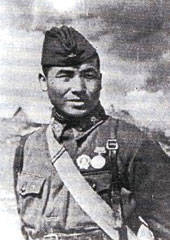
Scout platoon commander, Lieutenant Sirojetdin Valiev
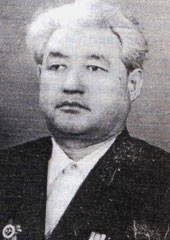
Private reconnaissance of the 74 th rifle division of the 12 th army Tulegen Koshkinbayev
In the battles for the Caucasus, troop scout D.S. Kalinin. He successfully commanded a reconnaissance group operating in the rear of the enemy, destroyed the command post, several vehicles of the enemy.
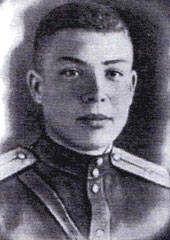
Scout of the 395 Division of the 56 Army Senior Lieutenant Vasily Danilovich Ponomarev
Actively acted and other military scouts. They underwent special mountaineering training, acquired skills of action in the mountains at the school of military mountaineering under the guidance of famous climbers, masters of sports B.V. Grachev and instructors L.M. Maleinova, E.V. Abalakova, A.I. Sidorenko, P.I. Sukhova and others.
Acting in small groups, military intelligence officers penetrated into the rear of the German troops, created panic in the defense of the enemy, and laid ways to enter the strike forces in the main directions.
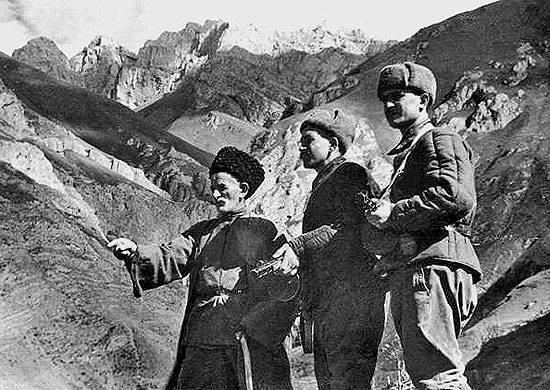
At the direction of the commander of the 56 Army, Lieutenant-General A.A. Grechko formed a large reconnaissance and sabotage detachment to act in the rear of the enemy, headed by Lieutenant Colonel S.I. Perminov.
The detachment consisted of fighter-sabotage groups, summarized in motor intelligence numbering more than 300 reconnaissance, 75-th battalion of anti-tank guns and a squad of sappers. In total, the squad had 480 people. The Perminov detachment successfully acted in the enemy's rear, inflicting significant casualties and manpower on it.
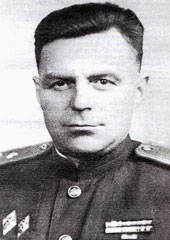
Colonel Stepan Ivanovich Perminov. During the Great Patriotic War, deputy chief of intelligence of the 56 Army of the North Caucasus Front, honorary citizen of the city of Abinsk, Krasnodar Territory
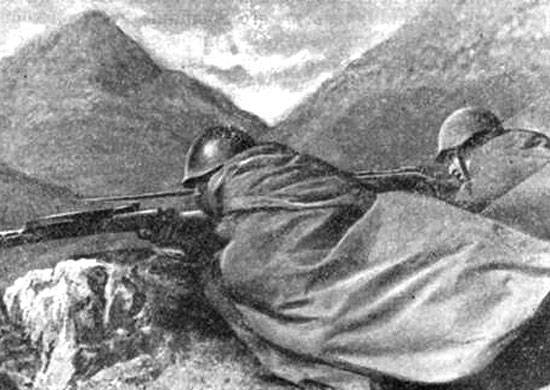
During the battle for the Caucasus, radio intelligence also distinguished itself. The radio divisions of the North Caucasus Front were able to correctly establish the grouping of enemy troops on the Taman Peninsula, provided timely information about the movements of the enemy headquarters and their actions (in particular, the actions of the 44th and 5th army, 49th mountain rifle and 3rd tank buildings), revealed the strengthening of the enemy’s group in order to eliminate the bridgehead on the Malaya Zemlya in the region of Novorossiysk. In addition, radio intelligence of this front continuously monitored the basing aviation enemy in the Crimea and its rear areas.
Fleet intelligence acted decisively
An important role in the battle for the Caucasus was gained by the interaction of the Red Army and the forces of the Black Sea Fleet. By this time, the fleet suffered heavy losses in ships as a result of fierce battles, and the very existence of the Black Sea Fleet largely depended on the Red Army’s retention of the Caucasian coast: in early August 1942 the enemy reached Krasnodar, and the threat of a breakthrough under the Novorossiysk and Tuapse directions was created . With the capture of Anapa, the situation near Novorossiysk became even more complicated, and the capabilities of basing the ships of the fleet were reduced to a minimum — only a few Georgian ports remained.
To support the combat activities of the Black Sea Fleet and the interacting units of the Red Army, as well as to maintain the operational regime at the Black Sea Theater of Operations (theater), the fleet headquarters actively conducted operational reconnaissance throughout the theater.
A characteristic feature of the intelligence activities of the Black Sea Fleet was that it had to solve tasks not only in the interests of the fleet, but also to a greater extent in the interests of the army command, as a result of which the enemy’s naval forces and aviation. This circumstance forced naval intelligence officers to study new objects of intelligence, new methods of obtaining intelligence information about the enemy. This was especially true of radio intelligence officers who, in the pre-war years, were completely unprepared for the reconnaissance of ground forces and did not know the ground enemy communications system.
The organization of reconnaissance operations was led by the head of the intelligence department of the headquarters of the Black Sea Fleet, Colonel D. B. Namgaladze The deputy chief of the RO of the fleet headquarters was Captain 2 of rank S.I. Ivanov, the subdivisions of the fleet radio intelligence were commanded by lieutenant colonels I.B. Aizinov, I.Ya. Lavrishchev and S.D. Kurland. The organization of military intelligence was carried out by captain S.L. Yermash.
To carry out operational intelligence, radio intelligence from the Caspian flotilla, reconnaissance and partly combat aviation, reconnaissance units (groups) of the fleet headquarters, the Azov flotilla and the Novorossiysk naval base, submarines, surface ships at sea, as well as coastal defense units and monitoring and communications fleet.
Radio reconnaissance, reconnaissance aviation and reconnaissance groups, as well as units and units of radio reconnaissance of the fleet and the Caspian flotilla made a significant contribution to solving enemy reconnaissance missions during the battle for the Caucasus, and especially during the preparation of the Novorossiysk landing operation.
During the battle for the Caucasus, the 3 coastal radio squadron of the Black Sea Fleet was actively engaged in radio intelligence of the enemy. The objects of radio intelligence were the Air Force and the naval forces of Germany, Romania, Turkey, as well as some enemy army units.
In the summer of 1942, during the period of intense military operations in the North Caucasus, the radio intelligence of the Black Sea Fleet reported to the command that the enemy’s fleet received considerable reinforcement: torpedo boats, minesweepers, large self-propelled artillery barges, six submarines and small vessels of various types. The composition and number of Romanian units operating against the Don Front were clarified. Intelligence officers promptly reported to the fleet commanders about the creation of operational groups of Romanian headquarters in Rostov, the transfer of mountain infantry units under Novorossiysk and Nalchik, as well as other important information about the enemy.
In the days of the Battle of Stalingrad, the radio-direction-finding station of the radio detachment commanded by Senior Lieutenant B.G. Suslovich, was in the area of Stalingrad, extracting valuable information about the enemy, which were transferred to the headquarters of the boom division of General A.I. Rodimtsev. In 1942-1943 this XF radio station has changed its location once.
Great work of the Black Sea Fleet radio intelligence officers was carried out in tracking the actions of the enemy's reconnaissance aircraft. They found that reconnaissance aircraft operated on the Southern Front as part of nine groups of Yu-88 and Xe-111 aircraft, which were based on airfields in Mariupol, Saki and Nikolaev. Other enemy airfields were opened, for which permanent radio observation was established and conducted.
One of the most important tasks of the squadron was the timely opening of a network of radar stations (radar) of the enemy, which used radar on the Black Sea widely. Two radar networks in the Crimea were identified, which included 11 radar stations, which were accounted for by the Black Sea Fleet and aviation during combat operations. Were also identified the network of the enemy radar on the territory of Romania.
During the battle for the Caucasus, the intelligence of the Black Sea Fleet played a significant role. Throughout the entire period, operations of the fleet and ground forces were planned taking into account the information that was obtained by the radio intelligence forces of the Black Sea Fleet.
In general, during the battle for the Caucasus, the 3 coastal radio squadron of the Black Sea Fleet handed over to the fleet headquarters:
2 thousand reports on the activities and deployment of surface ships and submarines of the enemy;
more than 2 thousands of reports on the activities of all types of German and Romanian aviation;
more than 3 thousands of reports on the detection by the forces of radio intelligence of the enemy ships of the Black Sea Fleet;
more 100 reports on the activities of the army units and enemy formations
During the battle for the Caucasus, the coastal detachment was commanded by Captain I.Ye. Markitanov. High professional skills were demonstrated by the radio intelligence officers B. Suslovich, V. Rakshenko, V. Sizov, I. Grafov, I. Liechtenstein, V. Storozhenko, S. Mayorov, V. Zaitsev, M. Guilman and others.
In the battles for the Caucasus, the radio reconnaissance of the coastal radio squadron of the Caspian Flotilla, commanded by Lieutenant Commander P. Ivchenko, distinguished themselves.
During the battle for the Caucasus, scouts acted bravely - the sailors of the Black Sea Fleet. One of them, Warrant Officer F. Volonchuk, took part in the defense of Sevastopol, carried out combat missions in the central part of the Main Caucasian Range, acted in the rear of the enemy in the Crimea, on the Kerch and Taman Peninsula. The scouts under the command of warrant officer Volonchuk defeated a police department in the Nazi-occupied Evpatoria, carried out a number of sabotage acts on the Yalta highway in the enemy's rear, and captured German soldiers on the Umpirsky Pass of the Main Caucasus Range.
Assessing the contribution of military intelligence to the liberation of the North Caucasus from the German invaders, the head of the GRU of the General Staff of the RF Armed Forces Hero of Russia, Army General V.V. Korabelnikov wrote: “Military scouts — officers of the intelligence departments of the headquarters of several fronts — the North Caucasus, Southern and Transcaucasian, and the headquarters of the Black Sea Fleet and the Azov Sea — took direct part in the numerous and diverse in form battles that became integral parts of the difficult battle for the Caucasus. and the Caspian Flotilla, the brave fighters of front-line intelligence. Important information about the long-term plans of the German command to conduct the war on the Soviet-German front in 1942-1943. and military intelligence officers, who operated in the capitals of a number of European states, in Iran, Iraq and Turkey, also mined. They were able to timely reveal the general plan of the German command action plan in the North Caucasus, identify the forces and means that were allocated by Hitler and his generals to capture the Caucasus oil-bearing regions, obtain information that prevented Turkey from entering the war against the USSR on the German side, and to ensure the safe supply to the 1942-1943 of USSR material assistance from the USA and England. ”
During the battle for the Caucasus, valuable information about the enemy was obtained by aerial reconnaissance of the Black Sea Fleet. In April-June 1943 alone, the Black Sea Fleet's aerial reconnaissance detected 232 enemy convoys, in which the 1421 ship was marked.
In the course of the battle for the Caucasus, strategic, operational, military and naval intelligence intelligence officers showed courage and heroism, high professional skills, reasonable initiative and perseverance. Acting in the mountains, they turned out to be stronger and more fortunate than specially trained German and Italian alpine shooters and reconnaissance and sabotage detachments of German intelligence. For one and a half years of the battle for the Caucasus, military intelligence officers obtained valuable information about the enemy and thereby contributed to the disruption of Operation Edelweiss, developed by the German command and envisaging the seizure of the North Caucasus. For deeds committed in the performance of tasks of command, many military intelligence officers were awarded orders and medals. GI military intelligence officers were awarded the high title of Hero of the Soviet Union. Vyglazov, N.A. Zemtsov, D.S. Kalinin.
Colonel V.M. proved to be skillful intelligence organizers during the battle for the Caucasus. Kapalkin (Head of the Intelligence Division, Headquarters of the North Caucasus Front in May – September 1942), Colonel N.M. Trusov (head of the intelligence department of the headquarters of the North Caucasus Front in January – December 1943), A.F. Vasiliev (head of the intelligence department of the headquarters of the Southern Front), N.V. Sherstnev (head of the intelligence department of the headquarters of the southern front in April - September 1942), PN. Vavilov (head of the intelligence department of the Transcaucasian Front), D. B. Namgaladze (head of the intelligence department of the headquarters of the Black Sea Fleet).
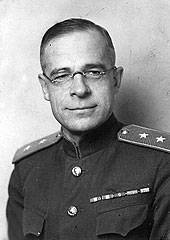
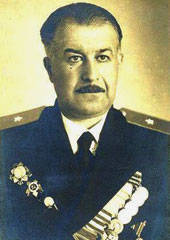
Common efforts tore down "Edelweiss"
The last stage of the battle for the Caucasus ended on October 9 1943. On this day, the Taman Peninsula was liberated. The operation of the German command, which had the code name "Edelweiss", was thwarted and ended in complete failure.
During the battle for the Caucasus, representatives of all types of military and naval intelligence distinguished themselves. Important information about the plans of the enemy was extracted by military intelligence officers of foreign (strategic) intelligence Shandor Rado, N.G. Lyakhterov, B.G. Razin, M.M. Volosyuk and others.
Army reconnaissance boldly and initiatively acted in the mountains and valleys of the Caucasus. Summing up the battle for the Caucasus, Marshal of the Soviet Union A.A. Grechko wrote after the war: “... The fighting in the Caucasus confirmed the importance of creating specially trained and armed detachments for operations in the high-mountainous zone. Therefore, during the fighting in the mountainous and wooded area, serious attention was paid to the bold and bold actions of small units. An important role was played by small sabotage fighter units that were sent to the rear of the enemy ... ".
The training of personnel for operations in the rear of the enemy was led by experienced military intelligence officers, who, together with these groups, were often in the rear of the enemy. One of such brave commanders was a military intelligence officer, commander of the reconnaissance company of the 56 Army Division of the North Caucasus Front, Lieutenant Colonel Stepan Ivanovich Perminov. After the end of World War II, military intelligence officer S.I. Perminov became an honorary citizen of the city of Abinsk, Krasnodar Territory.
During the battle for the Caucasus, reconnaissance fighters bravely fought - sailors of the Black Sea Fleet. One of them - midshipman F.F. Volonchuk. Together with his comrades, Volonchuk took part in the defense of Sevastopol, performed combat missions in the rear of the enemy in the Crimea, on the Kerch Peninsula, Taman, in the central part of the Main Caucasus Range.
One of the comrades of midshipman Volonchuk, midshipman Nikolai Andreevich Zemtsov, in 1943, for courage and heroism shown in carrying out the mission in the rear of the enemy, was awarded the title Hero of the Soviet Union.
The title of Hero of the Soviet Union was awarded to the military intelligence officer Captain Dmitry Semenovich Kalinin, who died in April 1943, fulfilling the task in the rear of the enemy.
Bravely fought for the freedom of the Caucasus and Colonel Haji-Umar Dzhiorovich Mamsurov - in 1942-1943. Chief of Operations and Assistant Chief of the Central Headquarters of the Partisan Movement. In 1945, Mr. H. Mamsurov was awarded the title Hero of the Soviet Union. In 1957-1968 Colonel-General Hadji Umar Dzhiorovich Mamsurov was the deputy chief of the Main Intelligence Directorate.
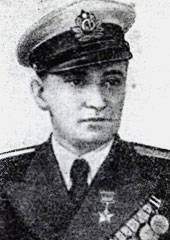 Hero of the Soviet Union, midshipman Nikolai Andreevich Zemtsov
Hero of the Soviet Union, midshipman Nikolai Andreevich ZemtsovThe last stage of the battle for the Caucasus was completed on October 9. 1943. Commander of the North Caucasus Front, Colonel-General I.Ye. Petrov issued an order that said: “... Today, October 9 1943, the troops of the 56 Army swiftly broke the last resistance of the enemy and in the morning 7.00 reached the shore of the Kerch Strait. The scattered remnants of the enemy were cut off from the crossing and exterminated. Kuban and Taman Peninsula were completely cleared of the enemy. The last stage of the battle for the Caucasus, which began in the autumn of 1943, on the Terek, near Novorossiysk, Tuapse, on the passes of the Main Caucasian Range, is over. The gates to the Caucasus have been tightly closed for the enemies of our Motherland ... ”
One of the veterans of military intelligence, Colonel Retired Pavel Ivanovich Sukhov, with whom I am well acquainted with my participation in the Battle of the Caucasus, once said:
- It was difficult to knock out the Germans from the Caucasus, but we did it and by common efforts tore down Edelweiss ...
Together, it means the efforts of all those soldiers, officers and generals who fought near Maikop, in Novorossiysk, Tuapse, on the outskirts of Rostov-on-Don, near Malgobek, Grozny and Ordzhonikidze (now Vladikavkaz).
Russia has always been the guarantor of peace and tranquility in the Caucasus. During the battle for the Caucasus, the Red Army, in whose ranks the best representatives of all Caucasian peoples fought, interacting with the Black Sea Fleet and partisan detachments, protected this ancient, beautiful and rich region from devastation that inevitably threatened it in the event of a seizure by fascist Germany.
In October, 1943, the operation of the German troops "Edelweiss" suffered a complete collapse. The exploits accomplished by the soldiers and officers of the Red Army, among whom were military intelligence officers, were not forgotten.
Keeping the memory of those who selflessly defended the Caucasus during the Great Patriotic War, in 1973 the city of Novorossiysk was awarded the title “Hero City”, and modern Russia in 2007-2011. awarded the cities of Anapa, Vladikavkaz, Malgobek, Nalchik, Rostov-on-Don and Tuapse the honorary title "City of Military Glory."
Information